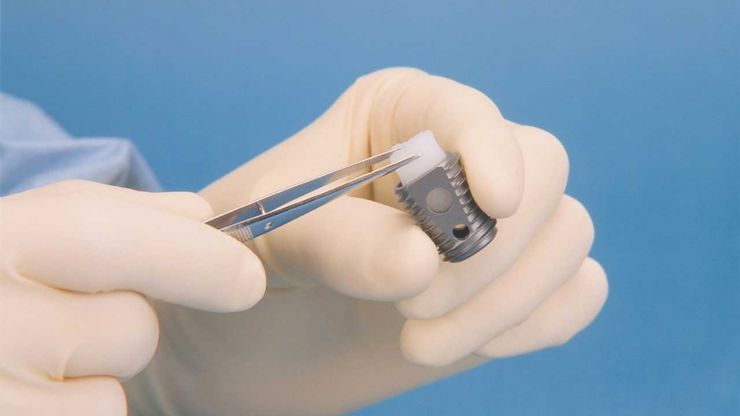Spinal Cages

The "cage" is a piece of equipment that has been descrbed in the newspapers, magazines, journals, and Internet. It is one of the treatment options that may be considered depending on the specific characteristics of your spinal problem.
This item is about as big as the end of your finger from the last joint to the tip. It is hollow and has holes in the sides, thus the name "cage." It is like a bird cage with a flat bottom and rounded top and has threads on the outside for fixation. The cage is used primarily in the lumbar spine as a disc replacement spacer and is used in pairs - inserted one on the right side of the disc space and the other on the left to give good lateral support. This setup is similar to building blocks or standing stools - you want the pressure supported equally toward the outside of the disc space for balance and distribution of weight so as not to break or collapse.
To review our spine anatomy, remember the disc is that cushion that sits between each bony vertebral body in our entire spine. All our discs tend to dehydrate or degenerate over time, but some break down sooner than others - those being primarily in the lower lumbar spine, where there is more stress on the spine, and cervical spine or neck discs which have the most movement. The discs in the neck are about as wide as a soda straw and the lower back discs about as wide as your finger. When these wear out and start collapsing, which is a general aging or an abuse process, obviously the space gets flatter or shorter. Many times, this is not a problem for a lot of people, but some have difficulties with the collapse because during this process, some disc material and even bony spurs form around the small window just above the disc in the spinal canal. This is where the nerve roots exit the spine to perform their functions in our legs or arms and becomes obstructed, causing disability in some of the extremities, i.e., pain or weakness.
Traditionally, in the neck, a wedge of bone from the hip is surgically placed in this disc space in the front of the neck. This has also been done in the lower back through the belly or the backside. The problem has been that in the past, the bony disc replacement has tended to collapse because of the amount of pressure placed on this substitute replacement, the same as the disc.
Therefore, the cage was invented or devised through many trials of shapes, sizes, and materials to the present stage with the FDA-approved titanium cage that can be inserted in the disc space from the front or back of the lower body that is filled with some bone chips and allowed in the support. This distracts the vertebral bodies and allows the nerve roots more room to exit and relieve the pain for a painful collapsing disc space. Sometimes this disc replacement must be accompanied by a screw and rod construct for extra support, depending on the patient's weaknesses in that spine area.
The entire procedure of cage placement can be done in one stage and sometimes two stages are necessary. Again, this depends on the patient's individual problem which is discussed preoperatively with each patient that meets the criteria for this procedure. Unlike claims made in news articles, this is not a procedure for everyone with back or leg pain or both. A thorough workup by your surgeon is required. If you do meet the requirements, the results can be quite successful.
Another option for individuals with a herniated cervical disc may be cervical disc replacement. Our team is expert in this emergent technology.
